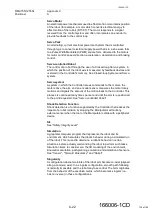
C-19
166006-1CD
166006-1CD
Appendix C
R
RM2-755/1255SL
Positioner
Real-time System
A computer system in which the computer is required to perform its tasks
within the time restraints of some process simultaneously with the system
it is assisting. The computer processes system data (input) from the
sensors for the purpose of monitoring and computing system control
parameters (outputs) required for the correct operation of a system or
process. The computer is required to do its work fast enough to keep pace
with an operator interacting with it through a terminal device (such as a
screen or keyboard). The operator interacting with the computer has
access, retrieval and storage capability through a database management
system. System access allows the operator to intervene and alter the
system's operation.
Record-playback Robot
A Manipulator for which the critical points along desired trajectories are
stored in sequence by recording the actual values of the joint-position
encoders of the robot as it is moved under operational control. To perform
the task, these points are played back to the robot's servo-system. See
.
Rectangular-Coordinate Robot
A robot whose Manipulator arm moves in linear motions along a set of
Cartesian or rectangular axis in X, Y and Z directions. The shape of the
work envelope forms a rectangular figure. See
.
Reliability
The probability or percentage of time that a device will function without
failure over a specified time period or amount of usage (R15.02). Also
called: the robot's uptime or the Mean Time Between Failure (MTBF).
Remanufacture
To upgrade or modify robots to the revised specifications of the
manufacturer. (R15.06)
Remote Mode
Remote Mode is a type of Play Mode where the automatic execution of
robot program is initiated from an external device (not the Programming
Pendant). During this mode, the use of the Programming Pendant is
disabled.
Repeatability
A measure of how close an arm can repeatedly obtain a taught position.
For instance: once a Manipulator is manually placed in a particular
location and this location is resolved by the robot, the repeatability
specifies how accurately the Manipulator can return to that exact location.
The degree of resolution within the robot control system determines the
repeatability. In general, an arm's repeatability can never be better than its
resolution. See
and
Resolution
The amount of robot joint motion required for the position sensing to
change by one count. Although the resolution of each joint feedback
sensor is normally constant, the resolution of the endpoint in world
coordinates is not constant for revolute arms, due to the non-linearity of
the arm's kinematics.
Revolute Joint
The joints of a robot, which are capable of rotary motion.
136 of 145



























